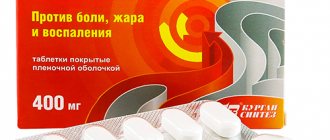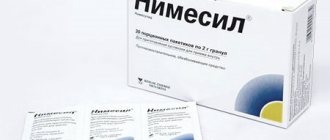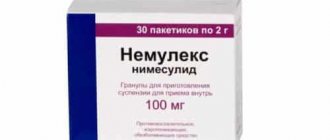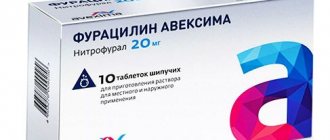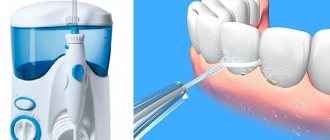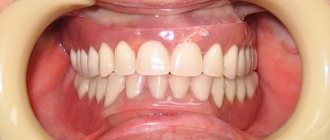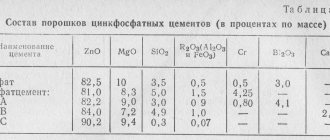Release form, composition
The drug Nimesil is available in a dosage form, a powder for the preparation of a suspension, which is intended for oral administration. It has a light green color, coarse grain, and an orange scent. The main active component of the drug is nimesulide, its content in 1 sachet of powder is 100 mg. The drug also contains additional compounds, which include:
- Sucrose.
- Orange flavor.
- Ketomacrogol.
- Anhydrous citric acid.
- Maltodextrin.
Nimesil powder is packaged in aluminum foil bags of 2 g each. A cardboard pack contains 9, 15 or 30 bags.
Comparison of ease of use of Nimesil and Nimulid
This includes dose selection taking into account various conditions and frequency of doses. At the same time, it is important not to forget about the release form of the drug; it is also important to take it into account when making an assessment.
The ease of use of Nimesil is approximately the same as Nimulid. However, they are not convenient enough to use.
The drug ratings were compiled by experienced pharmacists who studied international research. The report is generated automatically.
Last update date: 2020-12-04 13:44:25
pharmachologic effect
The main active ingredient of Nimesil is nimesulide, which is a sulfonamide. This substance suppresses the activity of cyclooxygenase-2 in the body, the enzyme responsible for the production of prostaglandins, which are synthesized during the development of pathological processes. A decrease in the amount of synthesized prostaglandins, as a result of exposure to nimeslin, helps to reduce irritation of nerve endings in the area of inflammation, which, in turn, leads to the disappearance of pain.
After entering the body, the drug begins to act actively. It is easily absorbed from the stomach and intestines, penetrates the blood, binding to plasma proteins. The largest amount of active substance in the blood is observed approximately 2-3 hours after taking the medicine. The main metabolic processes take place in the liver, and the resulting inactive products are eliminated within 6 hours (half-life).
According to research results, repeated use of the drug does not cause accumulation.
Comparison of the effectiveness of Nimesil and Nimulid
The effectiveness of Nimesil is quite similar to Nimulid - this means that the ability of the drug substance to provide the maximum possible effect is similar.
For example, if the therapeutic effect of Nimesil is more pronounced, then using Nimulid even in large doses will not achieve this effect.
Also, the speed of therapy - an indicator of the speed of therapeutic action - is approximately the same for Nimesil and Nimulid. And bioavailability, that is, the amount of a drug reaching its site of action in the body, is similar. The higher the bioavailability, the less it will be lost during absorption and use by the body.
Indications for use of Nimesil
Nimesil is prescribed for:
- pain syndromes of various origins (headache, dental pain, menstrual pain, consequences of injuries, postoperative pain, pain from rheumatism, etc.);
- infectious and inflammatory diseases (traumatic and postoperative inflammation)
- degerative and inflammatory diseases of the musculoskeletal system (arthritis, osteoarthrosis, osteochondrosis, bursitis, radiculitis, rheumatism, etc.);
- urological, gynecological and vascular diseases;
- diseases accompanied by increased body temperature.
This remedy is appropriate both for long-term treatment therapy and for dulling severe pain syndromes.
Patient reviews
Alla, 35 years old
If pulpitis occurs, the doctor recommended taking Nimesil. He quickly eliminated severe toothache. The next day, when the severe pain had already disappeared, I went to see a dentist to treat a bad tooth.
Sergey Ivanovich, 60 years old
I have been suffering from osteoarthritis of the knee joints for several years. When the disease worsens, severe pain occurs and it becomes impossible to walk. In this case, the doctor advised taking Nemulex. I take the drug according to the instructions prescribed by the doctor. After a few days, the pain subsides.
Contraindications
Before taking the medication, you must eat the contraindications indicated by the manufacturer. In particular, it is prohibited to take it in the following situations:
- Hypersensitivity to the active base (nimesulide) or an auxiliary component of the drug.
- History of hyperergic reactions of the body: rhinitis, urticaria, bronchospasm, laryngospasm associated with taking any drug from the NSAID group, including nimesulide.
- History of hepatotoxic reactions of the body to nimesulide.
- Simultaneous treatment with other drugs that have hepatotoxic effects (especially from the NSAID group).
- Inflammatory processes in the intestines in the acute phase (Crohn's syndrome, nonspecific ulcerative colitis).
- Recovery period after coronary artery bypass surgery.
- Fever that accompanies colds and acute respiratory viral infections.
- A combination of bronchial asthma, polyposis of the paranasal sinuses or nose with a recurrent course and a history of intolerance to NSAIDs;
- Exacerbation of a stomach or duodenal ulcer;
- History of ulcer with bleeding or perforation;
- History of cerebrovascular and other bleeding;
- Diseases accompanied by bleeding;
- Severe bleeding disorder;
- Severe heart failure;
- Severe renal failure;
- Confirmed hyperkalemia;
- Liver disease in the acute phase;
- Liver failure;
- Children under 12 years old;
- Pregnancy, lactation;
- Drug addiction, alcoholism.
Prescribed with caution for the following pathologies and factors:
- heart failure of any degree;
- severe arterial hypertension;
- diabetes mellitus type 2;
- IHD;
- hereditary fructose intolerance;
- malabsorption of glucose-galactose;
- sucrose-isomaltose deficiency;
- dys- or hyperlipidemia;
- cerebrovascular pathologies;
- severe somatic illnesses;
- arterial diseases (peripheral);
- infection caused by Helicobacter pylori;
- creatinine clearance less than 60 ml/min;
- long-term treatment with NSAIDs;
- elderly age;
- smoking.
Instructions:
Clinical and pharmacological group
05.009 (NSAIDs. Selective COX-2 inhibitor)
Release form, composition and packaging
Granules for the preparation of a suspension for oral administration in the form of a light yellow granular powder with an orange odor.
| 1 pack (2 g) | |
| nimesulide | 100 mg |
Excipients: ketomacrogol 1000, sucrose, maltodextrin, anhydrous citric acid, orange flavor.
2 g - laminated paper bags (9) - cardboard packs. 2 g - laminated paper bags (15) - cardboard packs. 2 g - laminated paper bags (30) - cardboard packs.
pharmachologic effect
Non-steroidal anti-inflammatory drug from the sulfonamide class. Has anti-inflammatory, analgesic and antipyretic effects. Nimesulide acts as an inhibitor of the cyclooxygenase enzyme responsible for the synthesis of prostaglandins and inhibits mainly cyclooxygenase-2.
Pharmacokinetics
After oral administration, the drug is well absorbed from the gastrointestinal tract, reaching Cmax in the blood plasma after 2-3 hours. Plasma protein binding is 97.5%. T1/2 is 3.2-6 hours. Easily penetrates histohematic barriers.
Metabolized in the liver using the cytochrome P450 (CYP) 2C9 isoenzyme. The main metabolite is the pharmacologically active parahydroxy derivative of nimesulide - hydroxynimesulide. Hydroxynimesulide is excreted in the bile in a metabolized form (found exclusively in the form of glucuronate - about 29%).
Nimesulide is excreted from the body, mainly by the kidneys (about 50% of the dose taken). The pharmacokinetic profile of nimesulide in elderly people does not change when administered single and multiple/repeated doses.
According to an experimental study conducted in patients with mild to moderate renal failure (creatinine clearance 30-80 ml/min) and healthy volunteers, the Cmax of nimesulide and its metabolite in the plasma of patients did not exceed the concentration of nimesulide in healthy volunteers. AUC and T1/2 in patients with renal failure were 50% higher, but within the pharmacokinetic range. When taking the drug again, no accumulation is observed.
Dosage
Nimesil is taken orally, 1 sachet (100 mg of nimesulide) 2 times a day. It is recommended to take the drug after meals. The contents of the sachet are poured into a glass and dissolved in approximately 100 ml of water. The prepared solution cannot be stored.
Nimesil is used only to treat patients over 12 years of age.
Adolescents (ages 12 to 18 years): Based on the pharmacokinetic profile and pharmacodynamic characteristics of nimesulide, no dose adjustment is necessary in adolescents.
Patients with impaired renal function: based on pharmacokinetic data, there is no need for dose adjustment in patients with mild to moderate forms of renal failure (creatinine clearance 30-80 ml/min).
Elderly patients: when treating elderly patients, the need to adjust the daily dose is determined by the physician based on the possibility of interaction with other drugs.
The maximum duration of treatment with nimesulide is 15 days.
To reduce the risk of unwanted side effects, the minimum effective dose should be used for the shortest possible course.
Overdose
Symptoms: apathy, drowsiness, nausea, vomiting, pain in the epigastric region. With maintenance therapy for gastropathy, these symptoms are usually reversible. Gastrointestinal bleeding may occur. In rare cases, increased blood pressure, acute renal failure, respiratory depression and coma, and anaphylactoid reactions are possible.
Treatment: carry out symptomatic therapy. There is no specific antidote. If an overdose has occurred within the last 4 hours, it is necessary to induce vomiting and/or provide activated carbon (adults from 60 to 100 g) and/or an osmotic laxative. Forced diuresis and hemodialysis are ineffective due to the high binding of the drug to proteins (up to 97.5%). Monitoring of kidney and liver function is indicated.
Drug interactions
Pharmacodynamic interactions:
When used together with glucocorticosteroids, the risk of gastrointestinal ulcers or bleeding increases.
When used together with antiplatelet agents and selective serotonin reuptake inhibitors (SSRIs), such as fluoxetine, the risk of gastrointestinal bleeding increases.
NSAIDs may enhance the effect of anticoagulants such as warfarin. Due to the increased risk of bleeding, this combination is not recommended and is contraindicated in patients with severe coagulation disorders. If combination therapy cannot be avoided, careful monitoring of blood clotting parameters is necessary.
Diuretics:
NSAIDs may weaken the effect of diuretics.
In healthy volunteers, nimesulide temporarily reduces the excretion of sodium under the influence of furosemide, to a lesser extent the excretion of potassium, and reduces the diuretic effect itself.
The combined use of nimesulide and furosemide leads to a decrease (by approximately 20%) in the area under the congestion curve.
From the respiratory system: infrequently - shortness of breath; very rarely - exacerbation of bronchial asthma, bronchospasm.
From the digestive system: often - diarrhea, nausea, vomiting; infrequently - constipation, flatulence, gastritis; very rarely - abdominal pain, dyspepsia, stomatitis, tarry stools, gastrointestinal bleeding, ulcer and/or perforation of the stomach or duodenum; very rarely - hepatitis, fulminant hepatitis, jaundice, cholestasis, increased activity of liver enzymes.
From the urinary system: rarely - dysuria, hematuria, urinary retention; very rarely - renal failure, oliguria, interstitial nephritis.
General disorders: rarely - malaise, asthenia; very rarely - hypothermia.
Other: rarely - hyperkalemia.
Storage conditions and periods
Storage conditions:
List B. Store in a dry place, protected from light and out of reach of children, at a temperature not exceeding 25 °C.
Best before date:
2 years.
Do not use after the expiration date stated on the package.
Indications
- treatment of acute pain (back pain, lower back pain; pain syndrome in the musculoskeletal system, including injuries, sprains and dislocations of joints, tendonitis, bursitis; toothache);
— symptomatic treatment of osteoarthritis with pain syndrome;
- algodismenorrhea.
The drug is intended for symptomatic therapy, reducing pain and inflammation at the time of use.
Contraindications
- history of hyperergic reactions, for example, bronchospasm, rhinitis, urticaria, associated with taking acetylsalicylic acid or other NSAIDs, incl. nimesulide;
- history of hepatotoxic reactions to nimesulide;
- concomitant (simultaneous) use of drugs with potential hepatotoxicity, for example, paracetamol or other analgesic or non-steroidal anti-inflammatory drugs;
- inflammatory bowel diseases (Crohn's disease, ulcerative colitis) in the acute phase;
— the period after coronary artery bypass grafting;
— fever in infectious and inflammatory diseases;
- complete or partial combination of bronchial asthma, recurrent nasal polyposis or paranasal sinuses with intolerance to acetylsalicylic acid and other NSAIDs (including a history);
- peptic ulcer of the stomach and duodenum in the acute phase, a history of ulcers, perforation or bleeding in the gastrointestinal tract;
- a history of cerebrovascular bleeding or other bleeding, as well as diseases accompanied by bleeding;
- severe blood clotting disorders;
- severe heart failure;
- severe renal failure (creatinine clearance <30 ml/min), confirmed hyperkalemia;
- liver failure or any active liver disease;
- children under 12 years of age;
- pregnancy and breastfeeding;
- alcoholism, drug addiction;
- hypersensitivity to the components of the drug.
With caution: severe forms of arterial hypertension, type 2 diabetes mellitus, heart failure, coronary heart disease, cerebrovascular diseases, dyslipidemia/hyperlipidemia, peripheral arterial disease, smoking, CC < 60 ml/min, anamnestic data on the presence of ulcerative lesions of the gastrointestinal tract, infections, caused by Helicobacter pylori; elderly age; long-term previous use of NSAIDs; severe somatic diseases; concomitant therapy with the following drugs: anticoagulants (for example, warfarin), antiplatelet agents (for example, acetylsalicylic acid, clopidogrel), oral glucocorticosteroids (for example, prednisolone), selective serotonin reuptake inhibitors (for example, citalopram, fluoxetine, sertraline).
The decision to prescribe Nimesil should be based on an individual risk-benefit assessment when taking the drug.
special instructions
Undesirable side effects can be minimized by using the minimum effective dose of the drug for the shortest possible short course.
Nimesil should be used with caution in patients with a history of gastrointestinal diseases (ulcerative colitis, Crohn's disease), since exacerbation of these diseases is possible.
The risk of gastrointestinal bleeding, ulceration or perforation of an ulcer increases with increasing dose of NSAIDs in patients with a history of ulcers, especially those complicated by bleeding or perforation, and in elderly patients, so treatment should be started with the lowest possible dose. Patients receiving drugs that reduce blood clotting or inhibit platelet aggregation also have an increased risk of gastrointestinal bleeding. If gastrointestinal bleeding or ulcers occur in patients taking Nimesil, treatment with the drug should be discontinued.
Since Nimesil is partially excreted by the kidneys, its dosage for patients with impaired renal function should be reduced, depending on the level of urination.
There is evidence of rare cases of liver reactions. If signs of liver damage appear (itching, yellowing of the skin, nausea, vomiting, abdominal pain, dark urine, increased activity of liver transaminases), you should stop taking the drug and consult your doctor.
Despite the rarity of visual impairment in patients taking nimesulide concomitantly with other NSAIDs, treatment should be stopped immediately. If any visual disturbance occurs, the patient should be examined by an ophthalmologist.
The drug can cause fluid retention in tissues, so patients with high blood pressure and cardiac problems should use Nimesil with extreme caution.
In patients with renal or heart failure, Nimesil should be used with caution, as renal function may deteriorate. If the condition worsens, treatment with Nimesil should be stopped.
Clinical studies and epidemiological data suggest that NSAIDs, especially at high doses and with long-term use, may lead to a small risk of myocardial infarction or stroke. There is insufficient data to exclude the risk of such events when using nimesulide.
The drug contains sucrose, this should be taken into account by patients suffering from diabetes mellitus (0.15-0.18 XE per 100 mg of the drug) and those on a low-calorie diet. Nimesil is not recommended for use in patients with rare hereditary diseases of fructose intolerance, glucose-galactose malabsorption or sucrose-isomaltose deficiency.
If signs of a “cold” or acute respiratory viral infection occur during treatment with Nimesil, the drug should be discontinued.
Nimesil should not be used simultaneously with other NSAIDs.
Nimesulide can change the properties of platelets, so caution must be exercised when using the drug in people with hemorrhagic diathesis, however, the drug does not replace the preventive effect of acetylsalicylic acid in cardiovascular diseases.
Elderly patients are especially susceptible to adverse reactions to NSAIDs, including life-threatening gastrointestinal bleeding and perforation, deterioration of renal, liver and cardiac function. When taking the drug Nimesil for this category of patients, proper clinical monitoring is necessary.
Like other drugs of the NSAID class that inhibit prostaglandin synthesis, nimesulide can adversely affect pregnancy and/or embryo development and can lead to premature closure of the ductus arteriosus, hypertension in the pulmonary artery system, impaired renal function, which can lead to renal failure with oligodyramnia, to an increased risk of bleeding, decreased uterine contractility, and the occurrence of peripheral edema. In this regard, nimesulide is contraindicated during pregnancy and lactation. The use of the drug Nimesil can negatively affect female fertility and is not recommended for women planning pregnancy. When planning a pregnancy, consultation with your doctor is necessary.
There is evidence of the occurrence in rare cases of skin reactions (such as exfoliative dermatitis, Stevens-Johnson syndrome, toxic epidermal necrolysis) to nimesulide as well as to other NSAIDs. At the first signs of a skin rash, damage to the mucous membranes or other signs of an allergic reaction, Nimesil should be discontinued.
The effect of the drug on the ability to drive vehicles and operate machinery.
The effect of the drug Nimesil on the ability to drive vehicles and operate machinery has not been studied, therefore, during treatment with the drug Nimesil, caution should be exercised when driving vehicles and engaging in potentially hazardous activities that require increased concentration and speed of psychomotor reactions.
Use for renal impairment
In patients with renal failure, Nimesil should be used with caution, as renal function may deteriorate. If the condition worsens, treatment with Nimesil should be stopped. The drug is contraindicated in severe renal failure (creatinine clearance <30 ml/min).
In patients with mild to moderate forms of renal failure (creatinine clearance 30-80 ml/min), there is no need for dose adjustment.
Use for liver dysfunction
The drug is contraindicated in liver failure or any active liver disease.
Conditions for dispensing from pharmacies
The drug is available with a prescription.
Side effects
Before using the medication, it is extremely important to familiarize yourself with the list of possible side effects provided by the manufacturer:
- increased potassium levels in the blood;
- mild general weakness, decreased body temperature;
- anemia, thrombocytopenia;
- problems with urination, development of kidney failure;
- sweating, skin rashes of various types, dermatitis, erythema, nephrotic edema;
- disturbances in the normal functioning of the liver (in particular, the synthesis of certain enzymes);
- headache and dizziness, causeless anxiety, apathy, drowsiness;
- visual impairment;
- shortness of breath, coughing attacks;
- disruption of the gastrointestinal tract, bleeding, ulcers;
- increase in pressure.
In order to reduce the likelihood of side effects, it would be best to minimize the dose of medication taken and shorten the duration of treatment with it as much as possible.
Compound similarities
These drugs have the same release form - water-soluble powder. Their therapeutic effects are similar. Both drugs effectively reduce temperature and eliminate pain.
Nemulex contains the active substance – nimesulide.
Additional components:
- macrogol;
- sucrose;
- flavoring agents;
- citric acid;
- silicon.
The medicine has analgesic, anti-inflammatory, antipyretic, and antiaggregation properties. The product has good digestibility. The medicine remains at its highest concentration in the blood for 2.5 hours.
The drug quickly enters the lesion and is excreted by the liver and kidneys. Nemulex suppresses prostaglandins in the inflammatory focus. The medicine is used to treat negative symptoms. The medication eliminates pain and prevents the development of inflammation.
Indications for use:
- arthritis;
- muscle pain;
- joint pain;
- bursitis;
- tenosynovitis;
- pain during menstruation;
- headache;
- toothache;
- pain syndrome during the development of intervertebral hernia;
- pain after injuries and operations.
The product does not have a therapeutic effect, but eliminates pain and inflammation of an episodic nature.
Indications for use of Nemulex: arthritis, muscle pain, joint pain.
Nimesil is produced in the form of granules for oral administration and suspension. The active substance is the same - nimesulide.
Additional components:
- macrogol;
- maltodextrin;
- lemon acid;
- sucrose;
- flavorings.
The medicine is a non-hormonal anti-inflammatory drug. It has anti-inflammatory, antipyretic and analgesic properties.
The drug reduces the synthesis of prostaglandins by inhibiting cyclooxygenase. After oral administration, the drug is well absorbed, reaching its highest concentration in the blood after 2-3 hours. The drug is metabolized in the liver.
Indications for use:
- elimination of pain syndrome;
- relief from primary dysmenorrhea.
How to dilute Nimesil powder - instructions for use
According to the instructions, Nimesil powder is intended for preparing a suspension that is taken orally.
One sachet is dissolved in 1 glass of water with a volume of 100 ml. The prepared suspension should be used immediately; it cannot be stored. The average therapeutic dosage is 100 mg of nimesulide (1 sachet) 2 times a day.
The maximum duration of treatment with Nimesil powder should not exceed 15 days. Dosage adjustment is usually not required for adolescents over 12 years of age, the elderly, and patients with concomitant mild renal impairment.
Drug interactions
The drug enhances the effect of medications that are used to reduce blood clotting. Nimesil can also increase the effect of furosemide. When taking Nimesil and methotrexate simultaneously, side effects may worsen. Nimesulide quickly binds to plasma proteins, so persons treated with sulfonamides and hydantoin should be under close medical supervision. The drug enhances the effect of cyclosporine on the kidneys. If Nimesil is used simultaneously with lithium preparations, the concentration of lithium in the plasma will increase.
Treatment with Nimesil requires caution if blood pressure medications, diuretics, or other anti-inflammatory and painkillers are used in combination with it.
Interactions of the drug Nimesil
Patients using warfarin or other indirect anticoagulants, or acetylsalicylic acid, have an increased risk of bleeding when using Nimesil simultaneously, so this combination is not recommended, and in severe forms of bleeding disorders it is contraindicated. If such a combination cannot be avoided, regular monitoring of the state of the blood coagulation system is necessary. In healthy individuals, nimesulide temporarily reduces the diuretic effect of furosemide and the excretion of sodium and, to a lesser extent, potassium, therefore, when using nimesulide and furosemide simultaneously in cases of impaired renal or cardiac function, special caution should be exercised. There is evidence that NSAIDs reduce the clearance of lithium, which leads to increased plasma lithium levels and increased toxicity. If Nimesil is prescribed to a patient receiving lithium preparations, frequent monitoring of lithium levels in the blood plasma is required. When used simultaneously with glibenclamide, theophylline, warfarin, digoxin, cimetidine and antacids, no clinically significant interactions were observed. Caution should be exercised if nimesulide is prescribed less than 24 hours before or after taking methotrexate, since it is possible to increase the level of the latter in the blood plasma and increase its toxicity. When used simultaneously with cyclosporine, the nephrotoxicity of the latter may increase.
special instructions
According to Nimesil's instructions, if the patient has a risk of ulcers, gastrointestinal bleeding, as well as with simultaneous treatment with drugs from the above, Nimesil therapy is started with the lowest dose, monitoring the patient's condition. At the slightest side or undesirable reactions, treatment is stopped.
- Nimesil contains sucrose, which should be taken into account by patients with diabetes: 1 sachet contains 0.15-0.18 XE.
- If ARVI and colds occur during Nimesil therapy, treatment is stopped.
- During treatment with Nimesil, caution should be exercised when driving a car and performing precise, dangerous work.
Special Recommendations
Before you start taking Nimesil, you must carefully study the instructions supplied with the drug. There are a number of recommendations for the correct use of the drug, namely:
- The active component of Nimesil is not compatible with all medications, so before you start taking it, you must consult a doctor, making sure to notify the specialist about all the medications you are currently taking.
- When using the drug in an effective therapeutic dosage and subject to a short course of administration, the risk of side effects is significantly reduced.
- Moderate renal failure may require a downward adjustment of the drug dosage taken.
- An additional component of the powder is sucrose, so patients with diabetes should take the drug with extreme caution and regularly monitor their blood sugar levels.
- Nimesil should not be taken simultaneously with other drugs from the category of non-steroidal anti-inflammatory drugs.
- The effect of the components of Nimesil on the functioning of the central nervous system has not been fully studied, therefore, during treatment with the drug, you should not perform work that requires increased concentration of attention, or drive a car.
"Nimesil" in sachets should be sold in pharmacies with a doctor's prescription. It should not be taken on its own.
Analogs
The following drugs are similar in composition to the active substance nimesulide: Nemulex, Actasulide, Aponil, Ameolin, Aulin, Nimesulide, Nimulid, Sulaydin, etc. Some of them have a much lower cost with the same effectiveness as Nimesil.
The difference between granules for preparing a suspension and tablets (cheaper) is only that the effect occurs a little faster, due to faster absorption of the suspension, but the effectiveness remains the same.
Comparison of safety of Nimesil and Nimulid
The safety of a drug includes many factors.
At the same time, in Nimesil it is quite similar to Nimulid. It is important where the drug is metabolized: drugs are excreted from the body either unchanged or in the form of products of their biochemical transformations. Metabolism occurs spontaneously, but most often involves major organs such as the liver, kidneys, lungs, skin, brain and others. When assessing metabolism in Nimesil, as well as in Nimulid, we look at which organ is the metabolizing organ and how critical the effect on it is.
The risk-benefit ratio is when the prescription of a drug is undesirable, but justified under certain conditions and circumstances, with the obligatory observance of caution in use. At the same time, Nimesil does not have any risks when used, just like Nimulid.
Also, when calculating safety, it is taken into account whether only allergic reactions occur or possible dysfunction of the main organs. In other matters, as well as the reversibility of the consequences of using Nimesil and Nimulid.
Reviews from doctors and people
- Svetlana Kharkovaya, dentist. Toothache can be quite severe and should not be tolerated. Taking Nimesil can help the patient. Of course, it is very important to pay attention to possible side effects and contraindications - not everyone can take the medicine. In some cases, I recommend Nimesil to relieve pain after treatment or tooth extraction. And I can say with confidence that during my long practice, no one complained that Nimesil did not help or that it made me feel ill.
- Ekaterina Menshikova. Nimesil became a real salvation for me at the time when I was treating my teeth. The pain was unbearable, both before visiting the doctor and in the first days after treatment (two teeth had to be removed due to inflammation). The advantage of this medicine is that it is easily diluted and begins to act very quickly. Of course, there are cheaper analogues - but I don’t want to experiment, since Nimesil has already been tested by time.
Reviews
In most cases, reviews of the use of Nimesil are positive. The drug quickly and quite effectively eliminates the symptoms of inflammation and pain. In some cases, the drug is used as an antipyretic. Many note its long-lasting effect, when repeated use may not be required.
The main disadvantage of the drug is that patients note a negative effect on the organs of the digestive system. This is especially true for those who already have a history of pathological processes in the stomach or intestines. For them, taking Nimesil can have unpleasant consequences specifically from the digestive system.
